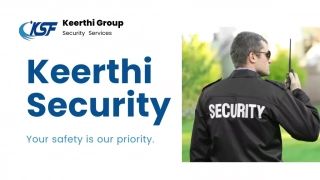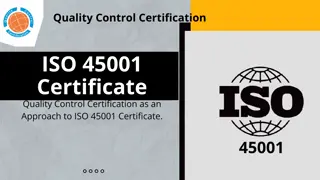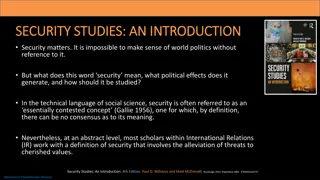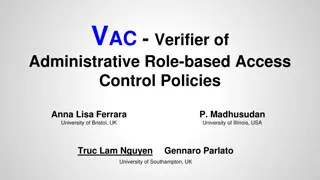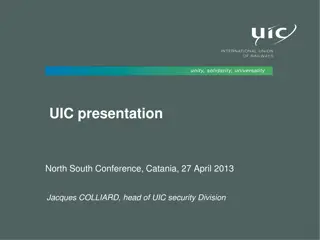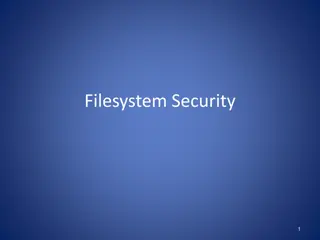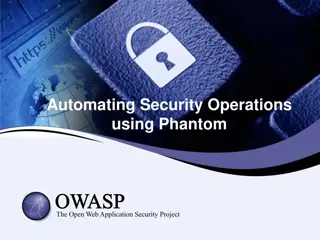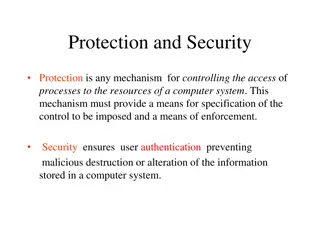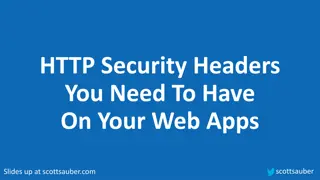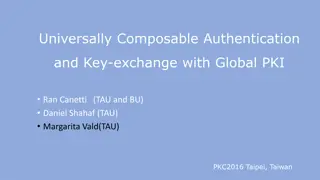IT Security and Control
Systems are vulnerable to various threats like viruses, hackers, and cyberterrorism. Security and control practices are crucial to mitigate risks and protect valuable information assets from potential harm and legal liabilities. This chapter discusses contemporary security challenges and vulnerabilities related to system vulnerability and abuse, emphasizing the importance of implementing robust security measures to safeguard critical data.
Download Presentation

Please find below an Image/Link to download the presentation.
The content on the website is provided AS IS for your information and personal use only. It may not be sold, licensed, or shared on other websites without obtaining consent from the author.If you encounter any issues during the download, it is possible that the publisher has removed the file from their server.
You are allowed to download the files provided on this website for personal or commercial use, subject to the condition that they are used lawfully. All files are the property of their respective owners.
The content on the website is provided AS IS for your information and personal use only. It may not be sold, licensed, or shared on other websites without obtaining consent from the author.
E N D
Presentation Transcript
4 Chapter IT Security and Control [Laudon] Chap 8 Dr. Yeffry Handoko Putra, M.T Magister of Information System Universitas Komputer Indonesia
Information System Managements Chapter 4 Security and Control SYSTEM VULNERABILITY AND ABUSE Why Systems Are Vulnerable Contemporary Security Challenges and Vulnerabilities
Information System Managements Chapter 4 Security and Control SYSTEM VULNERABILITY AND ABUSE Why Systems Are Vulnerable (Continued) Internet Vulnerabilities: Use of fixed Internet addresses through use of cable modems or DSL Lack of encryption with most Voice over IP (VoIP) Widespread use of e-mail and instant messaging (IM)
Information System Managements Chapter 4 Security and Control SYSTEM VULNERABILITY AND ABUSE Wi-Fi Security Challenges
Information System Managements Chapter 4 Security and Control SYSTEM VULNERABILITY AND ABUSE Malicious Software: Viruses, Worms, Trojan Horses, and Spyware, Hackers and Cybervandalism Computer viruses, worms, trojan horses Spyware Spoofing and Sniffers Denial of Service (DoS) Attacks Identity theft (e.g. Man in The Middle Attack/ MiTMA) Phishing Cyberterrorism and Cyberwarfare Vulnerabilities from internal threats (employees); software flaws
Information System Managements Chapter 4 Security and Control SYSTEM VULNERABILITY AND ABUSE Worldwide Damage from Digital Attacks
Information System Managements Chapter 4 Security and Control BUSINESS VALUE OF SECURITY AND CONTROL Inadequate security and control may create serious legal liability. Businesses must protect not only their own information assets but also those of customers, employees, and business partners. Failure to do so can lead to costly litigation for data exposure or theft. A sound security and control framework that protects business information assets can thus produce a high return on investment.
Information System Managements Chapter 4 Security and Control BUSINESS VALUE OF SECURITY AND CONTROL
Information System Managements Chapter 4 Security and Control BUSINESS VALUE OF SECURITY AND CONTROL
Information System Managements Chapter 4 Security and Control BUSINESS VALUE OF SECURITY AND CONTROL Security Incidents Continue to Rise Source: CERT Coordination Center, www.cert.org, accessed July 6, 2004.
Information System Managements Chapter 4 Security and Control BUSINESS VALUE OF SECURITY AND CONTROL Data Security and Control Laws: The Health Insurance Portability and Accountability Act (HIPAA) Gramm-Leach-Bliley Act Sarbanes-Oxley Act of 2002
Information System Managements Chapter 4 Security and Control BUSINESS VALUE OF SECURITY AND CONTROL Legal and Regulatory Requirements for Electronic Records Management 1. Electronic Records Management (ERM): Policies, procedures and tools for managing the retention, destruction, and storage of electronic records
Information System Managements Chapter 4 Security and Control BUSINESS VALUE OF SECURITY AND CONTROL Electronic Evidence and Computer Forensics 2. Electronic Evidence: Computer data stored on disks and drives, e-mail, instant messages, and e- commerce transactions 3. Computer Forensics: Scientific collection, examination, authentication, preservation, and analysis of computer data for use as evidence in a court of law
Information System Managements Chapter 4 Security and Control ESTABLISHING A MANAGEMENT FRAMEWORK FOR SECURITY AND CONTROL Types of Information Systems Controls 1. General controls: Software and hardware Computer operations Data security Systems implementation process
Information System Managements Chapter 4 Security and Control ESTABLISHING A MANAGEMENT FRAMEWORK FOR SECURITY AND CONTROL 2. Application controls: Input Processing Output
Information System Managements Chapter 4 Security and Control WHAT TO DO? Risk Assessment Security Policy Ensuring Business Business continuity and disaster recovery planning continuity
Information System Managements Chapter 4 Security and Control ESTABLISHING A MANAGEMENT FRAMEWORK FOR SECURITY AND CONTROL Risk Assessment: Determines the level of risk to the firm if a specific activity or process is not properly controlled
Information System Managements Chapter 4 Security and Control ESTABLISHING A MANAGEMENT FRAMEWORK FOR SECURITY AND CONTROL Security Policy: Policy ranking information risks, identifying acceptable security goals, and identifying the mechanisms for achieving these goals Acceptable Use Policy (AUP) Authorization policies
Information System Managements Chapter 4 Security and Control ESTABLISHING A MANAGEMENT FRAMEWORK FOR SECURITY AND CONTROL Security Profiles for a Personnel System
Information System Managements Chapter 4 Security and Control ESTABLISHING A MANAGEMENT FRAMEWORK FOR SECURITY AND CONTROL Ensuring Business Continuity 1. Downtime: Period of time in which a system is not operational 2. Fault-tolerant computer systems: Redundant hardware, software, and power supply components to provide continuous, uninterrupted service 3. High-availability computing: Designing to maximize application and system availability
Information System Managements Chapter 4 Security and Control ESTABLISHING A MANAGEMENT FRAMEWORK FOR SECURITY AND CONTROL Ensuring Business Continuity (Continued) 4. Load balancing: Distributes access requests across multiple servers 5. Mirroring: Backup server that duplicates processes on primary server 6. Recovery-oriented computing: Designing computing systems to recover more rapidly from mishaps
Information System Managements Chapter 4 Security and Control ESTABLISHING A MANAGEMENT FRAMEWORK FOR SECURITY AND CONTROL Ensuring Business Continuity (Continued) 7. Disaster recovery planning: Plans for restoration of computing and communications disrupted by an event such as an earthquake, flood, or terrorist attack 8. Business continuity planning: Plans for handling mission-critical functions if systems go down
Information System Managements Chapter 4 Security and Control ESTABLISHING A MANAGEMENT FRAMEWORK FOR SECURITY AND CONTROL Auditing: MIS audit: Identifies all of the controls that govern individual information systems and assesses their effectiveness Security audits: Review technologies, procedures, documentation, training, and personnel
Information System Managements Chapter 4 Security and Control ESTABLISHING A MANAGEMENT FRAMEWORK FOR SECURITY AND CONTROL Sample Auditor s List of Control Weaknesses
Information System Managements Chapter 4 Security and Control TECHNOLOGIES AND TOOLS FOR SECURITY AND CONTROL Access Control Access control: Consists of all the policies and procedures a company uses to prevent improper access to systems by unauthorized insiders and outsiders Authentication: Passwords Tokens, smart cards Biometric authentication
Information System Managements Chapter 4 Security and Control TECHNOLOGIES AND TOOLS FOR SECURITY AND CONTROL Firewalls, Intrusion Detection Systems, and Antivirus Software Firewalls: Hardware and software controlling flow of incoming and outgoing network traffic. Firewall Technology: Packet Filtering, Stateful inspection, Network Address Translation, Application Proxy Filtering Intrusion detection systems: Full-time monitoring tools placed at the most vulnerable points of corporate networks to detect and deter intruders
Information System Managements Chapter 4 Security and Control TECHNOLOGIES AND TOOLS FOR SECURITY AND CONTROL Firewalls, Intrusion Detection Systems, and Antivirus Software (Continued) Antivirus software: Software that checks computer systems and drives for the presence of computer viruses and can eliminate the virus from the infected area Wi-Fi Protected Access specification
Information System Managements Chapter 4 Security and Control TECHNOLOGIES AND TOOLS FOR SECURITY AND CONTROL A Corporate Firewall
Information System Managements Chapter 4 Security and Control TECHNOLOGIES AND TOOLS FOR SECURITY AND CONTROL Encryption and Public Key Infrastructure Public key encryption: Uses two different keys, one private and one public. The keys are mathematically related so that data encrypted with one key can be decrypted using only the other key Message integrity: The ability to be certain that the message being sent arrives at the proper destination without being copied or changed
Information System Managements Chapter 4 Security and Control TECHNOLOGIES AND TOOLS FOR SECURITY AND CONTROL Encryption and Public Key Infrastructure (Continued) Digital signature: A digital code attached to an electronically transmitted message that is used to verify the origin and contents of a message Digital certificates: Data files used to establish the identity of users and electronic assets for protection of online transactions Public Key Infrastructure (PKI): Use of public key cryptography working with a certificate authority
Information System Managements Chapter 4 Security and Control TECHNOLOGIES AND TOOLS FOR SECURITY AND CONTROL Two methods for encrypting network traffic on the Web are: Secure Sockets Layer (SSL) and its successor Transport Layer Security (TLS): protocols for secure information transfer over the Internet; enable client and server computer encryption and decryption activities as they communicate during a secure Web session. Secure Hypertext Transfer Protocol (S-HTTP): used for encrypting data flowing over the Internet; limited to Web documents, whereas SSL and TLS encrypt all data being passed between client and server.
Information System Managements Chapter 4 Security and Control TECHNOLOGIES AND TOOLS FOR SECURITY AND CONTROL Public Key Encryption
Information System Managements Chapter 4 Security and Control TECHNOLOGIES AND TOOLS FOR SECURITY AND CONTROL Digital Certificates
Information System Managements Chapter 4 Security and Control MANAGEMENT OPPORTUNITIES, CHALLENGES AND SOLUTIONS Management Opportunities: Creation of secure, reliable Web sites and systems that can support e-commerce and e-business strategies
Information System Managements Chapter 4 Security and Control MANAGEMENT OPPORTUNITIES, CHALLENGES AND SOLUTIONS Management Challenges: Designing systems that are neither overcontrolled nor undercontrolled Implementing an effective security policy
Information System Managements Chapter 4 Security and Control MANAGEMENT OPPORTUNITIES, CHALLENGES AND SOLUTIONS Solution Guidelines: Security and control must become a more visible and explicit priority and area of information systems investment. Support and commitment from top management is required to show that security is indeed a corporate priority and vital to all aspects of the business. Security and control should be the responsibility of everyone in the organization.




